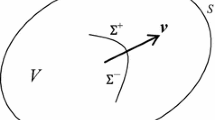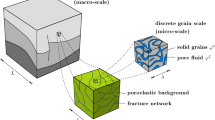Abstract
A dislocation can be represented by a moment tensor for calculating seismic waves. However, the moment tensor expression was derived in an elastic medium and cannot completely describe a dislocation in a porous medium. In this paper, effective moment tensors of a dislocation in a porous medium are derived. It is found that the dislocation is equivalent to two independent moment tensors, i.e., the bulk moment tensor acting on the bulk of the porous medium and the isotropic fluid moment tensor acting on the pore fluid. Both of them are caused by the solid dislocation as well as the fluid–solid relative motion corresponding to fluid injection towards the surrounding rocks (or fluid outflow) through the fault plane. For a shear dislocation, the fluid moment tensor is zero, and the dislocation is equivalent to a double couple acting on the bulk; for an opening dislocation or fluid injection, the two moment tensors are needed to describe the source. The fluid moment tensor only affects the radiated compressional waves. By calculating the ratio of the radiation fields generated by unit fluid moment tensor and bulk moment tensor, it is found that the fast compressional wave radiated by the bulk moment tensor is much stronger than that radiated by the fluid moment tensor, while the slow compressional wave radiated by the fluid moment tensor is several times stronger than that radiated by the bulk moment tensor.




Similar content being viewed by others
References
Aki, K., and Richards, P.G., Quantitative Seismology (2nd ed, University Science Books, Sausalito 2002).
Backus, G., and Mulcahy, M. (1976a), Moment tensors and other phenomenological descriptions of seismic sources – 1. Continuous displacements, Geophys. J. R. astr. Soc. 46, 341–361.
Backus, G., and Mulcahy, M. (1976b), Moment tensors and other phenomenological descriptions of seismic sources—2. Discontinuous displacements, Geophys. J. R. astr. Soc. 47, 301–329.
Baig, A., and Urbancic, T. (2010), Microseismic moment tensors: A path to understanding frac growth, The Leading Edge 29, 320–324.
Biot, M.A. (1956a), Theory of propagation of elastic waves in a fluid saturated porous solid: I. Low-frequency range, J. Acoust. Soc. Am. 28, 168–178.
Biot, M.A. (1956b), Theory of propagation of elastic waves in a fluid saturated porous solid:. High-frequency range, J. Acoust. Soc. Am. 28, 179–191.
Borak, B., and Friedman, G.M. (1981), Textures of sandstones and carbonate rocks in the world’s deepest wells (in excess of 30,000 ft. or 9.1 km): Anadarko Basin, Oklahoma, Sedimentary Geology 29, 133–151.
Boschi, E., and Mainardi, F. (1973), A representation theorem in the dynamic theory of porous media, Geophys. J. R. astr. Soc. 34, 313–320.
Burridge, R., and Knopoff, L. (1964), Body force equivalents for seismic dislocations, Bull. seism. Soc. Am. 54, 1875–1888.
Cheng, A.H.D, Badmus, T., and Beskos, D.E. (1991), Integral equation for dynamic poroelasticity in frequency domain with BEM solution, J. Eng. Mech. 117, 1136–1157.
Fischer, G.J., and Paterson, M.S., Measurement of permeability and storage capacity in rocks during deformation at high temperature and pressure, In Fault Mechanics and Transport Properties of Rocks (eds. Evans, B., and Wong, T.F.) (Academic Press, 1992) pp. 213–252.
Gao, Y., and Hu, H. (2010), Seismoelectromagnetic waves radiated by a double couple source in a saturated porous medium, Geophys. J. Int. 181, 873–896.
Haartsen, M.W., and Pride, S.R. (1997), Electroseismic waves from point sources in layered media, J. Geophys. Res. 102, 24745–24769.
Hu, H., and Gao, Y. (2011), Electromagnetic field generated by a finite fault due to electrokinetic effect, J. Geophys. Res. 116, B08302.
Hu, H., Guan, W., and Harris, J.M. (2007), Theoretical simulation of electroacoustic borehole logging in a fluid-saturated porous formation, J. Acoust. Soc. Am. 122, 135–145.
Johnson, D.L., Koplik, J., and Dashen, R. (1987), Theory of dynamic permeability and tortuosity in fluid-saturated porous-media, J. Fluid Mech. 176, 379–402.
Johnston, M.J.S., Mueller, R.J., and Sasai, Y. (1994), Magnetic field observations in the near-field the 28 June 1992 Mw 7.3 Landers, California, Earthquake, Bull. Seism. Soc. Am. 84, 792–798.
Karakelian, D., Beroza, G.C., Klemperer, S.L., and Fraser-Smith, A.C. (2002), Analysis of ultralow-frequency electromagnetic field measurements associated with the 1999 M 7.1 Hector Mine, California, Earthquake Sequence, Bull. Seism. Soc. Am. 92, 1513–1524.
Karpfinger, F., Müller, T.M., and Gurevich, B. (2009), Green’s functions and radiation patterns in poroelastic solids revisited, Geophys. J. Int. 178, 327–337.
Kozlovsky, Y.A. (1984), The world’s deepest well, Sci. Am. 251, 98–104.
Lockner, D.A., Tanaka, H., Ito, H., Ikeda, R., Omura, K., and Naka, H. (2009), Geometry of the Nojima Fault at Nojima-Hirabayashi, Japan—I. A simple damage structure inferred from borehole core permeability, Pure appl. geophys. 166, 1649–1667.
Matthäi, S.K., and Roberts, S.G., Transient versus continuous fluid flow in seismically active faults: an investigation by electric analogue and numerical modeling, In Fluid Flow and Transport in Rocks: Mechanisms and Effects (eds. Jamtveit, B., and Yardley, B.) (Chapman & Hall, London 1997) pp. 263–295.
Nagao, T., Orihara, Y., Yamaguchi, T., Takahashi, I., Hattori, K., Noda, Y., Sayanagi, K., and Uyeda, S. (2000), Co-seismic geoelectric potential changes observed in Japan, Geophys. Res. Lett. 27, 1535–1538.
Park, S.K., Dalrymple, W., and Larsen, J.C. (2007), The 2004 Parkfield earthquake: Test of the electromagnetic precursor hypothesis, J. Geophys. Res. 112, B05302.
Pride, S.R. (1994), Governing equations for the coupled electromagnetics and acoustics of porous media, Phys. Rev. B. 50, 15678–15696.
Pride, S.R., and Haartsen, M.W. (1996), Electroseimic wave roperties, J. acoust. Soc. Am. 100, 1301–1315.
Phillips, W.S., Rutledge, J.T., and House, L. (2002), Induced microearthquake patterns in hydrocarbon and geothermal reservoirs: Six case studies, Pure appl. geophys. 159, 345–369.
Ren, H., Chen, X., and Huang, Q. (2012), Numerical simulation of coseismic electromagnetic fields associated with seismic waves due to finite faulting in porous media, Geophys. J. Int. 188, 925–944.
Rudnicki, J.W., and Hsu, T-C. (1988), Pore pressure changes induced by slip on permeable and impermeable faults, J. Geophys. Res. 93, 3275–3285.
Shapiro, S.A., Fluid-Induced Seismicity (Cambridge University Press, 2015).
Vavryčuk, V., Bohnhoff, M., Jechumtálová, Z., Kolář, P., and Šílený, J. (2008), Non-double-couple mechanisms of microearthquakes induced during the 2000 injection experiment at the KTB site, Germany: A result of tensile faulting or anisotropy of a rock?, Tectonophysics 456, 74–93.
Wang, H.F., Theory of Linear Poroelasticity with Applications to Geomechanics and Hydrogeology (Princeton University Press, Princeton 2000).
Zheng, P., and Ding, B. (2015), Body force and fluid source equivalents for dynamic dislocations in fluid-saturated porous media, Transp. Porous. Med. 107, 1–12.
Acknowledgments
This work was supported by the National Natural Science Foundation of China (Grant Nos. 11372091, 41174110).
Author information
Authors and Affiliations
Corresponding author
Appendices
Appendix 1: Biot Bulk Wave Slownesses
The bulk wave slownesses in a poroelastic medium are given by
where \(\tilde \rho\), \(\varsigma\), and \(\rho_t\) are
and
respectively.
Appendix 2: The Coefficients in the Green’s Tensor Expressions
The coefficients in Eq. (42) are
Rights and permissions
About this article
Cite this article
Wang, Z., Hu, H. Moment tensors of a dislocation in a porous medium. Pure Appl. Geophys. 173, 2033–2045 (2016). https://doi.org/10.1007/s00024-015-1220-9
Received:
Revised:
Accepted:
Published:
Issue Date:
DOI: https://doi.org/10.1007/s00024-015-1220-9




